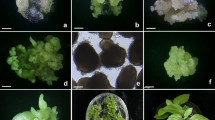Abstract
Embryogenic cultures of the common reed [Phragmites australis (Cav.) Trin. Ex. Steud.] were induced on Murashige and Skoog (1962)-based medium with 2% (w/v) sucrose, B5 vitamins and 4.5 μM 2,4-dichlorphenoxyacetic acid. Four independent culture lines, two initiated from stem nodes and two from roots, were established. These cultures underwent somatic embryogenesis. In one line of stem node origin, the somatic embryos germinated and developed into plants, following transfer of embryogenic cultures to Murashige and Skoog (1962)-based medium lacking growth regulators, with 108 ± 17 plants being recovered per 100 mg fresh weight of culture. In other lines, the somatic embryos developed roots, but not shoots. Shoot regeneration via somatic embryogenesis offers potential as anin vitro system for physiological studies, including assessments of the response of common reed to environmental pollutants.
Similar content being viewed by others
References
Armstrong J, Armstrong W & van der Putten WH (1996) Phragmites die-back: bud and root death, blockages within the aeration and vascular systems and the possible role of phytotoxins. New Phytol. 133: 399–414
Emons AMC & Kieft H (1991) Histological comparison of single somatic embryos of maize from suspension culture with somatic embryos attached to callus cells. Plant Cell Rep. 10: 485–488
Gamborg OL, Miller RA & Ojima K (1968) Nutrient requirements of suspension cultures of soybean root cells. Exp. Cell Res. 50: 151–158
McKee J & Richards AJ (1996) Variation in seed production and germinability in common reed (Phragmites australis) in Britain and France with respect to climate. New Phytol. 133: 233–243
Murashige T & Skoog F (1962) A revised medium for rapid growth and bioassays with tobacco tissue cultures. Physiol. Plant. 15: 473–479
Nitsch JP & Nitsch C (1969) Haploid plants from pollen grains. Science 163: 85–87
Sambrook J, Fritsch EF & Maniatis T (1989) Molecular Cloning: A Laboratory Manual. 2nd edition. Cold Spring Harbor Laboratory Press, New York
Sangwan RS & Gorenflot R (1975) In vitro culture of Phragmites tissues. Callus formation, organ differentiation and cell suspension culture. Z. Pflanzenphysiol. 75S: 256–269
Straub PF, Decker DM & Gallagher JL (1988) Tissue culture and long-term regeneration of Phragmites australis (Cav.) Trin. Ex. Steud. Plant Cell Tiss. Org. Cult. 15: 73–78
Ye ZH, Wong MH, Baker JM & Willis AJ (1998) Comparison of biomass and metal uptake between two populations of Phragmites australis grown in flooded and dry conditions. Ann. Bot. 82: 83–87
Author information
Authors and Affiliations
Corresponding author
Rights and permissions
About this article
Cite this article
Máthé, C., Hamvas, M.M., Grigorszky, I. et al. Plant regeneration from embryogenic cultures of Phragmites australis (Cav.) Trin. Ex Steud.. Plant Cell, Tissue and Organ Culture 63, 81–84 (2000). https://doi.org/10.1023/A:1006471515103
Issue Date:
DOI: https://doi.org/10.1023/A:1006471515103




